Most features of the general process of visual perception appear to be virtually universal rather than being culturally-specific. However, certain features do seem to be subject to some degree of cultural variability.
Everyone is thought to be subject to certain optical illusions, such as seeing grey areas at the intersections of what is known as the Hermann Grid...

Some other optical illusions seem to be culturally variable. One example is the Müller-Lyer Illusion...
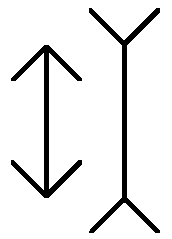
This illusion is well-known - most of us are aware that the vertical lines here are actually the same size but that the righthand line appears to be substantially longer. One explanation of why the righthand figure appears to be so much larger involves interpreting the images in depth. The righthand figure can be easily interpreted as representing the inside corner of a room whilst the arrowlike lefthand figure can be seen as the outside corner of a building. As an inside corner the righthand figure may appear to be nearer (and therefore larger) than the outside corner.
Experiments reported in 1966 by Segall, Campbell and Herskovitz suggested that the Müller-Lyer illusion may be absent or reduced amongst people who grow up in certain environments. They tested some Zulu people in South Africa who, at the time, lived in circular huts with arched doorways and had little experience of Western rectangular buildings. The Zulus seemed less affected by the Müller-Lyer illusion. The argument is that these people lived in a 'circular culture' whereas those who are more subject to the illusion live in a 'carpentered world' of rectangles and parallel lines (Segall, Campbell & Herskovits 1966). Europeans and Americans are more likely to interpret oblique and acute angles as displaced right angles and to perceive two-dimensional drawings in terms of depth.
So-called 'selective rearing' experiments have been conducted which involve rearing animals in conditions in which they are exposed only to certain kinds of perceptual experience such as only to vertical or to horizontal stripes. Whilst these experiments have been conducted with animals, Coren et al. (1994) argue that this can be seen as related to the way in which many human beings are selectively reared in rectilinear (or 'carpentered') urban environments (see Segall, Campbell & Herskovits 1996) in which the inhabitants are frequently exposed to lines in vertical and horizontal orientations. Coren et al. note that human vision shows a slight bias towards horizontal or vertical lines rather than oblique lines (Coren et al. 1994, 587). In experiments conducted by Hirsch (1972) and Blasdel et al. (1977), kittens which were reared only with vertical stripes had measurably lower visual acuity for stripes in other orientations.
Another well-known illusion of size is called simply the 'horizontal-vertical illusion. It is shown below...
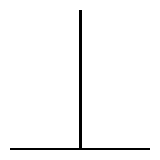
The lines are of equal length but the vertical one seems longer. This may be because the vertical line seems to recede in depth. The illusion may be stronger for people who are familiar with straight lines receding over a considerable distance. It has been argued that people who dwell in enclosed areas such as forests who are not used to vast open spaces and who have little opportunity to see the horizon or for great distances would be less susceptible to the horizontal-vertical illusion than those with long uninterrupted views. Segall, Campbell and Herskovits (1966) found that people who lived in very open rural environments tended to be more subject to the horizontal-vertical illusion than others. In very open environments height in the plane is a key depth cue.
The anthropologist Colin Turnbull described what happened in the former Congo in the 1950s when a BaMbuti pygmy, used in living in the dense Ituri forest (which had only small clearings), went with him to the plains:
-
And then he saw the buffalo, still grazing lazily several miles away,
far down below. He turned to me and said, 'What insects are those?'
At first I hardly understood, then I realized that in the forest vision is so limited that there is no great need to make an automatic allowance for distance when judging size. Out here in the plains, Kenge was looking for the first time over apparently unending miles of unfamiliar grasslands, with not a tree worth the name to give him any basis for comparison...
When I told Kenge that the insects were buffalo, he roared with laughter and told me not to tell such stupid lies. (Turnbull 1963, 217)
Because Kenge had no experience of seeing distant objects he saw them simply as small.
In a study reported in 1960, W Hudson and others investigated the influence of culture on visual perception amongst Bantu, European and Indian workers and children in South Africa and Ghana (Lloyd 1972, 61ff). Hudson used a set of picture cards, each including an elephant, an antelope and a man with a spear. In each one the spear was aligned with both the elephant and the antelope, but depth cues such as object size, superimposition and linear perspective clearly supported the interpretation that the spear was pointing towards the antelope rather than the elephant. Individuals were asked 'What do you see?', 'What is the man doing?' and 'Which is nearer the man, the elephant or antelope?'.
Hudson's results showed that at the beginning of primary school all of these children had difficulty perceiving the pictures as three-dimensional and said that the hunter was pointing his spear at whatever it was aligned with, regardless of cues as to depth. By the end of the primary school, virtually all of the European children interpreted the pictures in three dimensions, but some Bantu and Ghanian children still tended to see them as two-dimensional, as also did non-literate workers, both Bantu and European. and Indian children in South Africa.
Hudson concluded that 'formal schooling in the normal course is not the primary determinant in pictorial perception. Informal instruction in the home and habitual exposure to pictures play a much larger role' (cited in Cole & Scribner 1974, 68). The adequacy of Hudson's findings has been questioned, since greater success has been achieved when individuals are asked to respond by making models (ibid., 69-70). But it remains clear that pictorial conventions representing depth which literate European adults take for granted have to be learned.
Look at the next image...
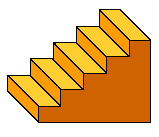
Asked for a quick description of this image, many people tend to describe a set of stairs going up. But of course you can go both ways on stairs. This response is likely to be influenced by the Western style of reading from left to right. Arabs, for instance, would read this (right to left) as a set of stairs going down.
Here is a famous 'impossible object', sometimes known as the Devil's Pitchfork...

After looking at it for a few moments, turn away and try drawing it. Are there three prongs or only two? Not suprisingly, this figure is sometimes given the paradoxical name of 'the two-pronged trident'. It is an impossible object since it could not be constructed in three dimensions - it only appears to be in three dimensions at first glance. You have to look quite carefully in order to realize this. This figure confuses many Western observers. The confusion arises from trying to interpret it as a three-dimensional figure. Deregowski (1969) found that people who habitually ascribed three-dimensionality to pictures had more difficulty in reproducing this figure than people who did not seek to impose three-dimensionality on images. The shorter the prongs the less easily fooled we are, which suggests that in the illusory version we are less able to relate one part to another.
The following image is an impossible object devised by L S and R Penrose...
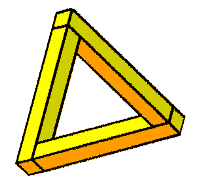
It is likely that much the same process is at work here. Whilst each of its intersections makes sense on its own, the parts could not physically be joined together. We have a powerful illusion of three-dimensionality because we don't initially notice how the parts relate to each other.
Another impossible object is this one (also devised by L S and R Penrose).
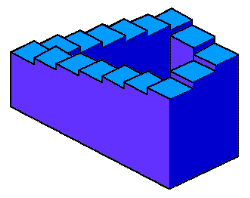
Only a cruel parent would suggest this as a Lego building-brick project for a child! The Dutch graphic artist Escher produced several variations on this theme. Here is a detail from one of them...
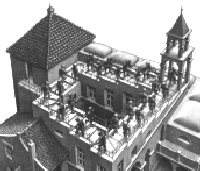
The perception of depth, and especially the cultural factors touched on briefly here, suggest that visual perception is in part at least learned. There is other evidence of this which is not dealt with here at all: in particular, perceptual development in childhood. This is a standard topic in psychology textbooks.
Another kind of evidence concerns adults learning to perceive differently using artificial devices. A number of experiments have explored perceptual learning by designing and using various kinds of goggles to alter the way in which things appear to those wearing them. Sometimes the goggles rotate the field of view so that, for instance, everything seems to be upside down or shifted to one side. A prism is often used. The goggles are sometimes worn for several weeks. Wearers typically report that the world at first seems very unstable. Some people can perform simple skills after only minutes of practice. After a few days it is often possible to do such things as riding a bicycle, and after a few weeks even skiing may be possible for those who could ski beforehand. After taking off such goggles, the world again seems to be unstable, though typically recovery occurs within an hour or so. You can simulate the early stages of using such spectacles by looking up at a hand-mirror slanted against your forehead and trying to do such things as pouring water into a cup.
-
Visual Perception 1: Searching for Patterns
-
Visual Perception 2: The Third Dimension
-
Visual Perception 3: Selectivity and Perceptual Constancy
-
Visual Perception 4: Cultural and Environmental Factors
-
Visual Perception 5: Individual Differences, Purposes and Needs
-
Visual Perception 6: Context and Expectations
-
Visual Perception 7: Gestalt Principles of Visual Organization
-
Visual Perception 8: The Moving Image
-
References and Suggested Reading

|